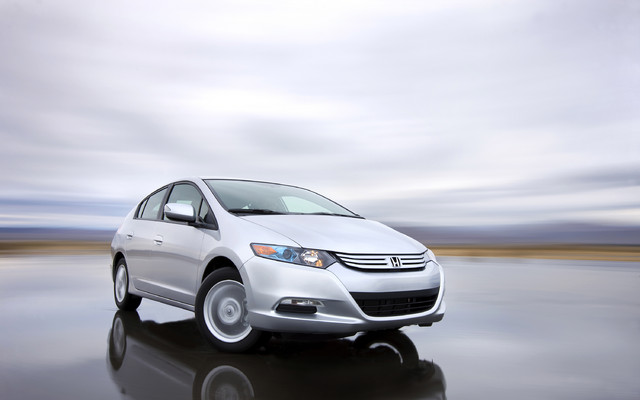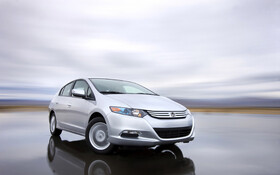A Little Insight Goes A Long Way: The 2010 Honda Insight

| Strong points |
|
|---|---|
| Weak points |
|
Vancouverites, like the denizens of too many other major cities, have recently fallen victim to a gang of rogue cyclists using the charade of Critical Mass events to expound the virtues of unrealistic political and environmental idealism. Initially disrupting (read: bringing to a standstill) our already maniacal Friday afternoon traffic in hopes of bringing awareness to the relatively lack of dedicated bicycle lanes in the city, Critical Mass has long since become a bastardized self indulgent stepchild of social disobedience; a mere soapbox for pedal-pushing hippies to roll out on grotesque two-wheeled sculptures, flaunt the law, and frustrate motorists for, near as I can tell, absolutely no reason.
Because here in Vancouver, we have predominantly two types of car: the hybrids, and the high performance. I came to this conclusion while seriously considering the ramifications of making a Honda Insight-sized path through a group of Critical Mass riders after hours of frustrating stop-and go traffic, and subsequently realized the futility of any environmental agenda our local Critical Masstards may subscribe to. Because, flanking either side of my diminutive Honda hybrid was a V10-powered BMW M6, and a Toyota Prius. One pointlessly forced to gulp down painfully expensive litres of premium petrol for absolutely no gain in forward progress, and the other already an environmentally enlightened driver who (by the expression on his face) didn’t appreciate the Critical Mass-enforced usage of his hybrid’s stop-start system. And I couldn’t help but wonder in Honda’s Insight would be the car to bring all this madness to an end.
As Honda’s first hybrid, the gen-one Insight was lauded for sacrificing everything in order to obtain the highest EPA fuel mileage estimate possible. Interior space, luxury, ride quality, handling, looks, and overall practicality were overlooked in order to push the be-wheel-spatted hatchback to an astounding 70 miles per gallon. This strict adherence to a singular purpose brought this incredibly frugal car almost on par with its sole competitor; but with hundreds of years of service under its belt and a vastly larger cockpit, the horse-drawn buckboard wasn’t to be outdone. Not surprisingly, the car was a complete and utter flop, and lasted just one year on the production line.
Now back with a relative vengeance, the second generation Insight has burst – nay – slowly shuffled onto the scene. Taking the lessons learned from the first car and applying them, Honda’s built something that is in no way similar to the original. There are four real doors, decent interior space (it is based upon the eminently flexible Fit platform, after all), decent looks, and a decent ride. Of course, all this luxury comes at a price, and the new Fit falls short of the original’s mileage figure; obtaining “just” 64.2 miles per gallon. A small price to pay for spat deletion.
But that’s not the only small price to pay: with the entry level model carrying a sticker price of just $23,900, the Insight undercuts every hybrid on the market today by a healthy margin. Bringing the cost of hybrid ownership to a new, more attainable level, it gives those looking to trade in their “One Less Car” bestickered bicycle a very compelling reason to come in from the cold. Sure, the interior belies the car’s modest Fit platform, but that’s ok. The seats are comfortable, the greenhouse vast, and the controls easy to manipulate. The soft touch materials on the dash exude a certain quality, and contrast well with the glossy black finish of the central stack. The gauge binnacle is standard Honda fare, albeit endowed with a glowing green and blue ball; the intricacies of which I’ll trust you to google.
Yes indeed, it will certainly surprise any ex-bicycle devotees with its comfort. However, for those more familiar with the products of the internal combustion engine, it may disappoint. The sleek roofline lends it a more fetching figure than its chief competitor (the Prius) but significantly cuts down on the rear seat headroom. The driver’s seating position will also be a bit of a stretch for those of us that are long of limb; the pedals are too close and vertically oriented and the steering wheel too far away. Out back, the nearly horizontal back glass captures confusing reflections off the road surface and distorts rearward vision. And then there’s the engine. Being of the Honda variety of hybrid, it never shuts off. Calling the electric motor into action for assistance, the whole system is slightly less efficient than the Prius’ dual-mode system, and provides performance that’s defined as missing. Your ability to merge at speed isn’t so much determined by pedal position so much as it is by the on ramp’s grade, and even the most conservative passing manoeuvres are quite simply left for more ambitious automobiles. Conversely, get stuck in traffic, and the CVT transmission surges with the unpredictability that would do a horde of traffic-blocking cyclists proud.
Which brings us back to the price. $8,920 more than an entry level Fit, the Insight simply doesn’t quite do enough to justify the additional expenditure. In fact, I found myself referring to the Insight as a Fit more than once during the test period; a mistake that tells a lot about the Insight’s personality. To put it in perspective, Canada’s Energuide gives an average annual fuel consumption cost of $1,300 for the 2009 Honda Fit. That means that $8,920 of savings to be had by purchasing a Fit represents 6.9 years’ worth of fuel for the average Honda Fit owner. Which basically means that for the 99% of the market that isn’t an image-obsessed environmentalist that feels the need to visibility flaunt your environmental ideals, the Insight probably isn’t the car for you. And for those of you who are gearing up to welcome thousands of motorists to the Friday afternoon commute from hell? Well, there’s plenty of real estate on the back bumper to support all your self-adhesive causes. Me? I’ll be hunting for a sticker that reads “One Less Bike” for my front bumper. You know, as a warning.











